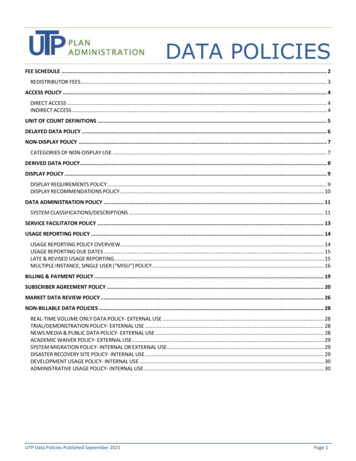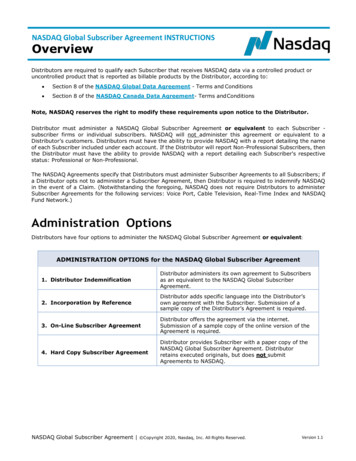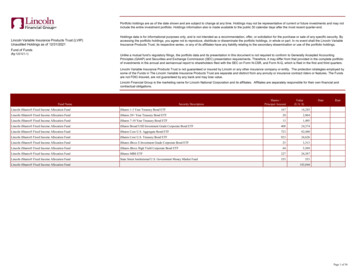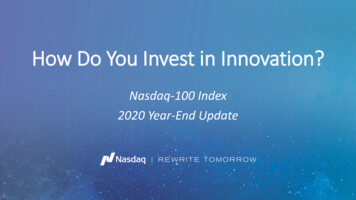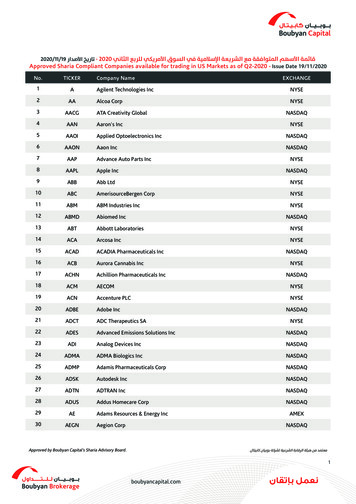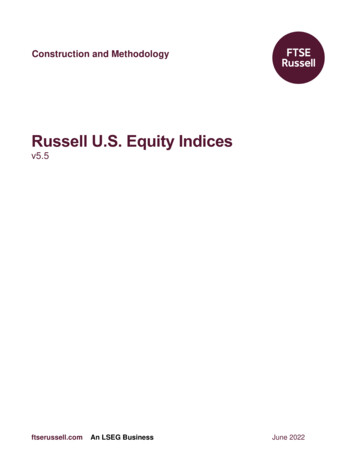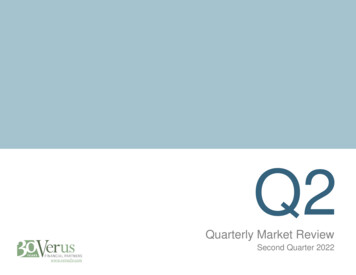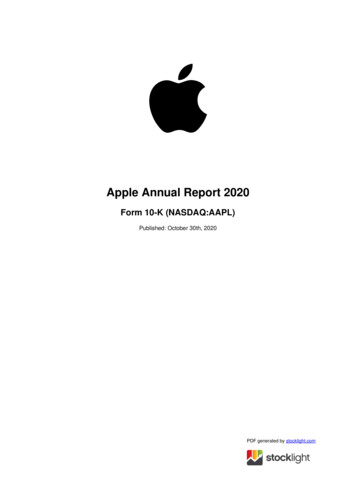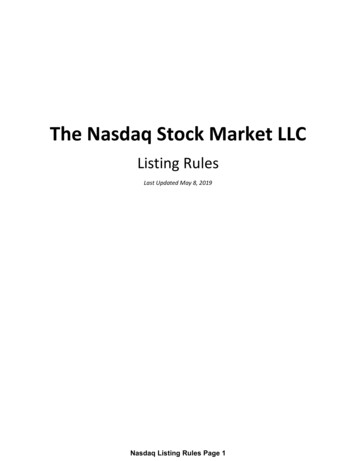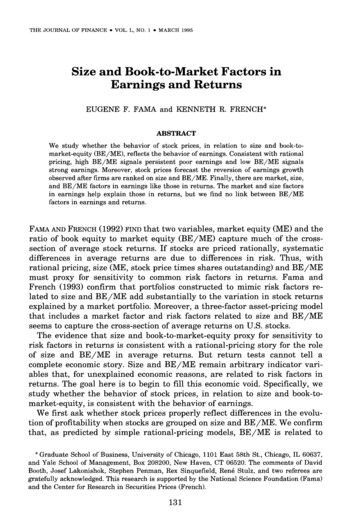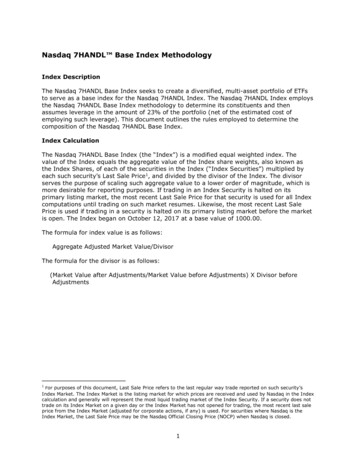
Transcription
Nasdaq 7HANDL Base Index MethodologyIndex DescriptionThe Nasdaq 7HANDL Base Index seeks to create a diversified, multi-asset portfolio of ETFsto serve as a base index for the Nasdaq 7HANDL Index. The Nasdaq 7HANDL Index employsthe Nasdaq 7HANDL Base Index methodology to determine its constituents and thenassumes leverage in the amount of 23% of the portfolio (net of the estimated cost ofemploying such leverage). This document outlines the rules employed to determine thecomposition of the Nasdaq 7HANDL Base Index.Index CalculationThe Nasdaq 7HANDL Base Index (the “Index”) is a modified equal weighted index. Thevalue of the Index equals the aggregate value of the Index share weights, also known asthe Index Shares, of each of the securities in the Index (“Index Securities”) multiplied byeach such security’s Last Sale Price1, and divided by the divisor of the Index. The divisorserves the purpose of scaling such aggregate value to a lower order of magnitude, which ismore desirable for reporting purposes. If trading in an Index Security is halted on itsprimary listing market, the most recent Last Sale Price for that security is used for all Indexcomputations until trading on such market resumes. Likewise, the most recent Last SalePrice is used if trading in a security is halted on its primary listing market before the marketis open. The Index began on October 12, 2017 at a base value of 1000.00.The formula for index value is as follows:Aggregate Adjusted Market Value/DivisorThe formula for the divisor is as follows:(Market Value after Adjustments/Market Value before Adjustments) X Divisor beforeAdjustmentsFor purposes of this document, Last Sale Price refers to the last regular way trade reported on such security’sIndex Market. The Index Market is the listing market for which prices are received and used by Nasdaq in the Indexcalculation and generally will represent the most liquid trading market of the Index Security. If a security does nottrade on its Index Market on a given day or the Index Market has not opened for trading, the most recent last saleprice from the Index Market (adjusted for corporate actions, if any) is used. For securities where Nasdaq is theIndex Market, the Last Sale Price may be the Nasdaq Official Closing Price (NOCP) when Nasdaq is closed.11
Three versions of the Index are calculated – a price return index, a total return index, and anet total return index. The price return index, the Nasdaq 7HANDL Base Index (NQ7HANDL), is ordinarilycalculated without regard to cash dividends on Index Securities.The total return index, Nasdaq 7HANDL Base TR Index (NQ7HANDLT), reinvests cashdividends on the ex-date.The net total return index, Nasdaq 7HANDL Base NTR Index (NQ7HANDLN),reinvests cash dividends on the ex-date based on the securities incorporationwithholding rate.2All Indexes reflect extraordinary cash distributions.The Indexes are calculated and disseminated once per second from 9:30:01 to 17:16:00Eastern Time (ET) in USD. The closing value of the Index(es) may change up until17:15:00 ET due to corrections to the Last Sale Price of the Index Securities.EligibilityIndex eligibility is limited to Exchange-Traded Funds (ETFs).Eligibility CriteriaTo be eligible for inclusion in the Nasdaq 7HANDL Base Index, an ETF must first meet thefollowing criteria: be an ETF organized under the Investment Company Act of 1940;have a three-month average daily trading volume of 20,000 shares (measuredannually during the Annual Reconstitution process);be open for daily creations and redemptions;be listed on a U.S. exchange;have traded for a minimum of one year.The Nasdaq 7HANDL Base Index is comprised of ETFs that are split into two categories, aCore Portfolio and an Explore Portfolio. Nasdaq relies upon an independent, third-party dataprovider to categorize ETFs in accordance with the methodology set forth below. The Core Portfolio consists of U.S. aggregate fixed-income ETFs3 (the Core FixedIncome Component) and U.S. large cap equity ETFs4 (the Core Equity Component). The Core Fixed Income Component shall be allocated on an equal weightbasis to the three U.S. aggregate fixed-income ETFs that have the lowestexpense ratios after waivers. The Core Equity Component shall be determined as follows:o Fifty percent of the Core Equity Component shall be allocated on anequal weight basis to the three U.S. large cap equity ETFs that havethe lowest expense ratios after waivers.The securities incorporation withholding rate is the percentage of dividends that must be withheld for nonresident investors who do not benefit from double taxation treaties with the United States. For securities domiciledin the United States (as all of the Index constituents are), the securities incorporate withholding rate is 30%.3U.S. aggregate fixed-income ETFs are defined as those ETFs that provide exposure to the entire U.S. investmentgrade bond market without limitation of duration or issuer.4U.S. large cap equity ETFs are defined as those ETFs that provide exposure to a similar market capitalizationrange as the large capitalization segment of the Nasdaq US Benchmark Index.22
o The remaining 50% of the Core Equity Component shall be allocated tothe largest ETF (by AUM) that tracks the Nasdaq-100 Index.The Core Portfolio consists of a 70% allocation to the Core Fixed IncomeComponent and a 30% allocation to the Core Equity Component.The Explore Portfolio consists of a momentum-tilted, optimized allocation to nonlevered ETFs in various U.S. asset categories that historically have provided highlevels of income (Explore Categories). The Explore Categories include the following 12 ETF categories:o Dividend Equity – ETFs that provide exposure to domestic dividendpaying stocks;o Covered Call – ETFs that provide exposure to indexed covered callportfolios based on either the S&P 500 Index or Nasdaq-100 Index;o High-Yield Bonds – ETFs that provide exposure to domestic high-yieldcorporate bonds (also known as “junk bonds”) of any duration ormaturity;o Investment Grade Bonds – ETFs that provide exposure to domesticinvestment grade corporate bonds [of any duration or maturity];o MLPs – ETFs that provide exposure to master limited partnerships;o MBS – ETFs that provide exposure to mortgage-backed securities;o Active Fixed Income – ETFs that provide broad exposure to activelymanaged fixed income ETFs that invest in securities of any duration ormaturity;o Preferred Securities – ETFs that provide exposure to domesticpreferred securities;o REITs – ETFs that provide exposure to domestic real estate investmenttrusts;o Growth & Income – ETFs that provide exposure to multiple assetportfolios of stocks and bonds or ETFs of stocks and bonds; includingfund-of-fund ETFs;o Utilities – ETFs that provide exposure to domestic utility securities; ando Build America Bonds – ETFs that provide exposure to Build AmericaBonds. Build America Bonds are taxable municipal bonds that includetax credits and/or federal subsidies for bondholders and state and localbond issuers. These bonds may be of any maturity or duration.Each Explore Category shall be represented in the Index by a single ETFbased on the following criteria:o The default rule (subject to the exception described below) shall bethat each Explore Category shall be represented by the largest ETF (byAUM) in the Explore Category.o Notwithstanding the default rule, if an ETF that is not the largest ETF(by AUM) in its Explore Category, it shall represent its ExploreCategory if it has an expense ratio after waivers at least 20% lowerthan the largest ETF (by AUM) in the Explore Category.o If multiple ETFs have an expense ratio after waivers at least 20%lower than the largest ETF (by AUM) in the Explore Category, the ETFwith the lowest expense ratio after waivers shall represent the ExploreCategory.The Explore Category allocation uses a proprietary methodology developed byNasdaq Dorsey Wright (\DWA). The 12 ETFs comprising the Explore Categoryare weighted based on the DWA Managed Momentum Score which is3
comprised of an ETF’s Relative Strength Weighting and Yield to RiskWeighting:o Relative Strength Weighting is constructed as follows: Each ETF is assigned a Relative Strength Score based on theaverage of their 12, 9, 6, 3, and 1-month returns; If the Relative Strength Score is positive, the ETF is assigned aRaw Momentum Weight of 16.67%; otherwise, the ETF receivesa Raw Momentum Weight of 4.17%; The Raw Momentum Weight is then rebased proportionally to100% in order to calculate a Relative Strength Weight.o Yield to Risk Weighting is constructed as follows: Each ETF if assigned a Composite Yield Score based on theaverage of their 12, 9, 6, 3, and 1-month dividend yield; Each ETF if assigned a Composite Volatility Score based on theaverage of their 12, 9, 6, 3, and 1-month annualized volatility; The Yield to Risk Weight is then calculated as Composite YieldScore divided by Composite Volatility Scoreo The DWA Managed Momentum Score is calculated as Relative StrengthWeighting multiplied by Yield to Risk Weighting.o The DWA Managed Momentum Score is then rebased proportionally to100% in order to calculate the Index Weight.If the DWA Managed Momentum Score results in one or more ETFs exceedingan Index Weight of 16.67%, the Index Weights of those ETFs will be cappedat 16.67% with the excess weight redistributed proportionally across alluncapped ETFs.Index EvaluationThe Index is evaluated annually in December. The above Eligibility Criteria are applied usingavailable market data as of the last trading day of the month. Security additions anddeletions are made effective at the market open on the 9th business day in January.Additionally, if at any time during the year other than the Evaluation, an Index Security isdetermined to have become ineligible for continued inclusion in the Index due to delisting,suspension, or a definitive agreement that would likely result in the security no longer beingIndex eligible, the security is removed from the Index and is replaced by the next eligibleETF from the investment category in question. Ordinarily, a security will be removed fromthe Index at its Last Sale Price. If, however, at the time of its removal the Index Security ishalted from trading on its primary listing market and an official closing price cannot readilybe determined, the Index Security may, in Nasdaq’s discretion, be removed at a zero price.The zero price will be applied to the Index Security after the close of the market but prior tothe time the official closing value of the Index is disseminated, which is ordinarily 17:16:00ET.4
Index MaintenanceIndex Share changes are not made outside of the evaluation; however, changes arisingfrom ETF dividends and ETF splits are made to the Index on the evening prior to theeffective date of such corporate action. In the case of certain spin-offs or rights issuances,the price of the Index Security is adjusted and a corresponding adjustment is made to theIndex Shares such that the weight of the Index Security does not change as a result of theaction.A special cash dividend announced by the listing exchange will result in an adjustment tothe Last Sale Price of an Index Security prior to market open on the ex-date for the specialamount distributed. A corresponding adjustment will be made to the Index Shares of thesecurity such that the weight of the Index Security will not change as a result of the action.A special dividend may also be referred to as extra, extraordinary, non-recurring, one-time,unusual, etc.Ordinarily, whenever there is a change in Index Shares, a change in an Index Security or achange to the price of an Index Security due to spin-offs, rights issuances or special cashdividends as mentioned above, the divisor is adjusted to ensure that there is nodiscontinuity in the value of the Index which might otherwise be caused by any suchchange.Index RebalancingThe index employs a modified equal weighting methodology and is rebalanced on a monthlybasis. Following the close of the last trading day of each month, the Index is rebalanced toan equal weighting between the Core and Explore Portfolios. Within each portfolio, the ETFsare weighted in accordance with the Eligibility Criteria. Changes in weighting are made atmarket open on the 9th trading day of each month.Nasdaq may, from time to time, exercise reasonable discretion as it deems appropriate inorder to ensure Index integrity.January 20185
The Nasdaq 7HANDL Base Index (the "Index") is a modified equal weighted index. The value of the Index equals the aggregate value of the Index share weights, also known as the Index Shares, of each of the securities in the Index ("Index Securities") multiplied by . the largest ETF (by AUM) that tracks the Nasdaq-100 Index.
